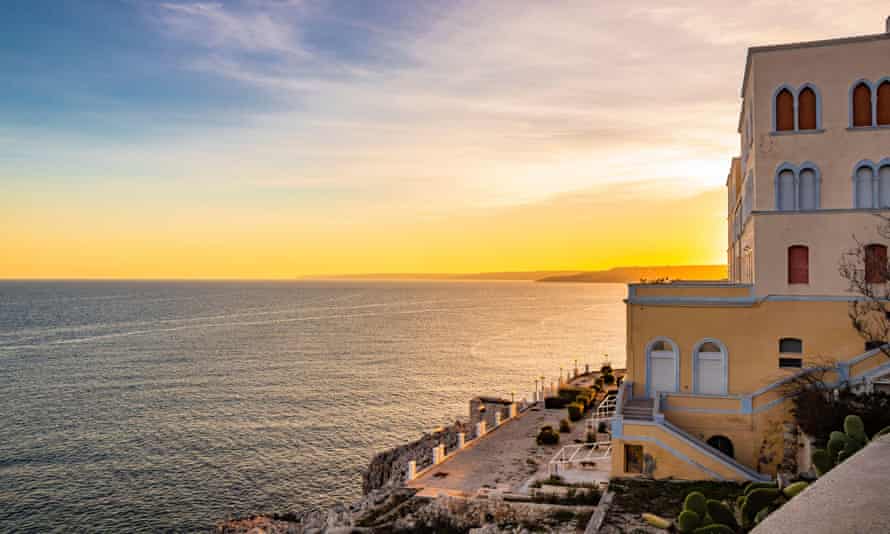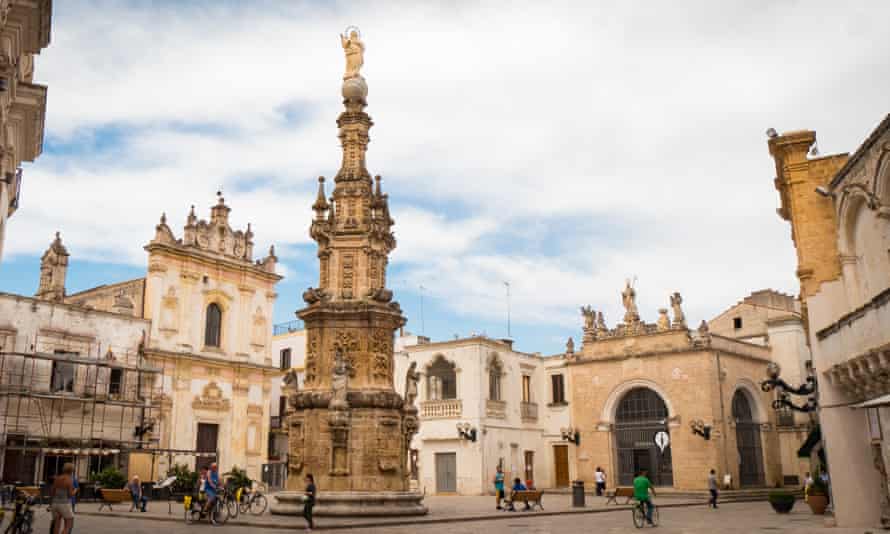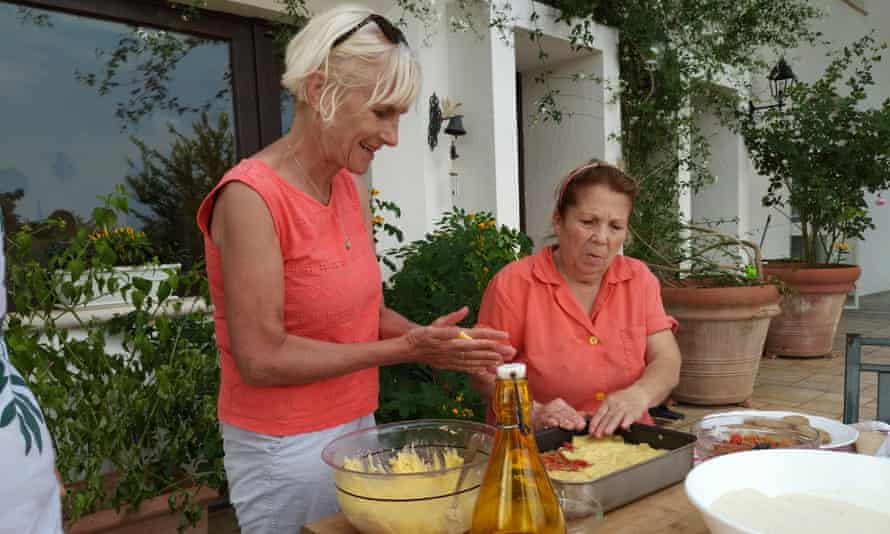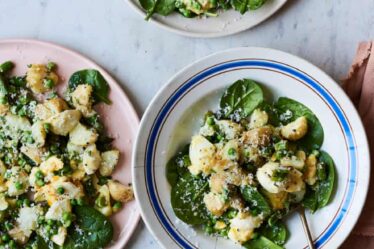
It was only as I wiped a hunk of bread around my plate that it dawned on me that the lunch we’d just eaten was entirely vegan. A plate of beans slowly stewed in a ceramic pot with onions, herbs, tomato and a whack of peperoncino (chilli) came with a slice of focaccia rustica (crusty pie filled with wild greens) and the world’s tastiest salad: fresh leaves, celery, carrots and tomatoes made toothsome with fennel flowers, capers, more fresh chillies, chives, gherkin and fruity olive oil.
But far from being some hip, plant-based city joint, the Caroppi cafe in the Puglian village of Specchia Gallone is an old-school bakery, run by the sort of large, welcoming family that might feature in your dream version of Italy’s south. Talkative Donato Caroppi showed us around – letting us peek at a sourdough “mother” more than 20 years old – then explained that in this region with too little rainfall for pasture, a mainly vegan diet was the norm for centuries.
We were on day two of a week’s e-bike tour of Salento, the southern tip of Puglia, and enjoying the way cycling took us deep into the folds of this ancient land, yet still allowed us to cover plenty of ground – and work up an appetite for meals like that.
And as well as getting a warm glow from exercise and sunshine, we could tell ourselves that our holiday was helping preserve the character of this area – because we were travelling with Salento Bici Tour, run by Carlo Cascione and Giulia Tenuzzo, who are as unabashed a pair of right-on lefties as you could wish to meet.
Both in their late 30s, they returned to Puglia after studying and working in Italy’s more prosperous north, and started the business to combine their twin passions – cycling and social enterprises, particularly ones involved in slow food – using tourist euros from one to bring extra income to the other. And being a pair of eco-minded foodies, my husband and I were very happy to mix organic wineries, sustainable farms and artisanal cheesemakers into our tour of coasts and historic hinterland.
As we’re older and less fit than Carlo and Giulia, we opted to use e-bikes – so we could ride 30-40 miles each day and still have energy to enjoy villages, lakes, castles, beaches. What a splendid invention the e-bike is: you’re still cycling, but have an invisible giant on hand to give you a push whenever you’re struggling.
Salento Bici Tour also runs group trips, but we were on a self-guided tour, made easier with directions in a handlebar-mounted GPS. We were soon pedalling out of Lecce, the “Florence of the South”, towards the Adriatic. Quiet, mostly well-surfaced narrow lanes between olive farms made perfect cycling terrain.
On our last visit to Puglia, six or seven years earlier, the olive groves had been glorious, but the tragedy that has hit southern Europe was now obvious. This is a region of 60m olive trees (to 4 million people), and the xylella fastidiosa bacteria has infected most of them. All around were dead and dying branches, some trees cut almost to a stump in an attempt to see off the bug, some groves newly planted.
Cyclists were an unusual enough sight for grizzled farmer Pasquale to stop his car and ask what we were doing in his olive groves. He was amazed to find people all the way from London in his remote corner. I asked about the trees. He spread his hands: “We do what we can. I have 40,000 trees – all for the cemetery.” But with admirable resilience he had replanted 10,000.

Each evening we would arrive in a spectacular coastal town – Otranto, with graphic mosaic floors in its Romanesque cathedral; or Leuca, with rows of art nouveau villas on Puglia’s tip. Gallipoli, on the Ionian coast, is less famous than its namesake in Turkey, but both come from Greek kalli polis, or beautiful city. Puglia’s version, on its own little island, lived up to the name as we cycled across its six-arch stone bridge at sunset, with buildings glowing pink, white and gold.
Each morning we’d slot the recharged batteries back into our bikes and pedal off, sometimes stopping for a seaside swim or picnic (wild Punta della Suina beach was idyllic, as was fjord-like Porto Badisco, said to be where Aeneas landed after escaping from Troy). But the most memorable stops were in sleepy inland spots chosen by Carlo. Near Otranto, by the Idro River, we sneaked through a metal fence into one of the area’s most evocative ancient places: a 1,000-year-old cripta (shallow cave) used by followers of Saint Basil fleeing persecution in the east in the ninth century. Their frescoes could still be made out on the stone walls.

Several days included lunch with a slow food partner. I Contadini preserves Salento produce using only what is at hand – salt and sunshine. In season, its fields are aglow, with sliced tomatoes, peppers, aubergines, courgettes and onions drying in the sun. A jar of pasta sauce made from yellow tomatoes shone like fresh orange juice, and I felt almost drunk on the aroma from a 1kg bag of freshly dried tomatoes.
We nearly missed lunch at Celacanto, part of a sustainable social enterprise near the east coast, because despite the GPS we’d gone sailing past it up a long hill. On ordinary bikes I’d have balked at the idea of toiling up that hill a second time, but on my e-bike it was no problem. We freewheeled back down and feasted on roasted and preserved vegetables, pecorino cheese from a small partner farm and glasses of astringent reddish-pink rosé wine.
Puglia is not all about tradition, though. At Cantine Menhir near Specchia Gallone, we saw how the region’s future is, well, rosé. Until the late 20th century, Salento wineries were by the station, for transporting strong plonk in bulk to the north or to France for blending. Menhir, started in 2002, is one of a new breed, now selling more than a million bottles a year of labelled organic wine. Its Pietra rosé is made to modern tastes, pale and aromatic (like Adele’s favourite, Whispering Angel); other triumphs were a complex Physis white, made with classic grillo grapes, and a velvety deep red negroamaro.
We made one lunch ourselves – at a cooking lesson in Tenuta DonnAnna, Carlo’s parents’ guesthouse. At a table in the garden we made orecchiette pasta, instructed by a central casting nonna called Teresa, barely 4ft 6in, but with powerful arms for pummelling dough into stretchy silkiness.

The following day was our last – a 32-mile hop back to Lecce – and I didn’t want it to end. We dawdled for the last few miles, relishing the silence, the lizards darting up drystone walls, the sun on our backs. We’d ridden almost 200 miles in six days but our batteries felt fully charged.
The trip was provided by Salento Bici Tour (UK tel 020-33 000794) whose one-week self-guided tours cost from €630pp, inc B&B, tastings, baggage transport and GPS guide. E-bike extra



